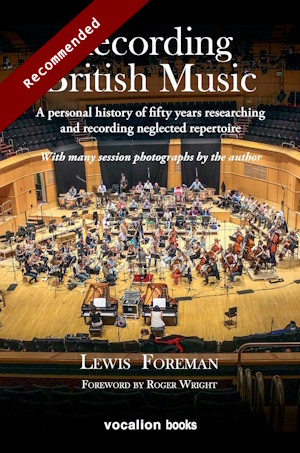
Recording British Music: A personal history of fifty years researching and recording neglected repertoire
By Lewis Foreman
Published 2024
xxxi, 426 pages. Hardback
ISBN: 978-1-9996796-2-0
Vocalion Books
Lewis Foreman’s name will be familiar in many musical guises: as author of more than thirty books (his magisterial biography of Arnold Bax is now in its third edition), as well as innumerable periodical articles and notes for concert programmes and recordings; as instigator and facilitator of performances and recordings of neglected (largely British) music, often involving detective work, finding and reconstructing performance materials and even the mundane but hugely important task of physically copying scores and parts; writing musical obituaries for the Independent newspaper, before it became wholly digital with a different policy for obituaries; and so on. All this the result of a passion for music, an encyclopaedic knowledge, and a seemingly inexhaustible energy for not only having ideas and inspiration, but seeing them realized, and is described in this book, which is one of the first products of a new venture by Mike Dutton, who has been responsible for so many of the pioneering recordings initiated by Foreman and has now extended his output to book publishing under the imprint Vocalion Books.
Where to start? First, one must say that the book is beautifully designed and produced (by Biddles of Kings Lynn) and a joy to hold and read, with various elements, such as lists of works by particular composers or given by particular performers, shown in such a way as to be easily accessible but not to interfere with the main text.
The other noteworthy element is the sheer number of illustrations, the majority being session photographs taken by the author himself: three sections of plates comprising 236 photographs, 40 figures in the text and 24 illustrations fronting each chapter. In addition are four appendixes illustrating 78 rpm labels, Lyrita CDs featuring portraits, etc. The first section of plates includes a sequence from the collection of Richard Itter, founder of Lyrita, among which is a page of contact prints of Sir Adrian Boult in the control room at a Lyrita recording session at Walthamstow in 1968.
This is of course one man’s account – but a man whose experience in these matters is surely unique – and the book begins with an autobiographical introduction, how it all began: music at school, public library collections and the BBC Third Programme were major providers of early grist to his mill; and when he became a librarian, developing the music library holdings at Ealing Central Library allowed him to become acquainted with the music publishing business, and a fascinating account of a now lost world of publishers in central London, swept away by amalgamations and takeovers, which also resulted in much music, otherwise readily available, being lost forever. Or was it? Foreman’s story tells of the rediscovery of many of these ‘lost’ pieces, and their performance and rehabilitation.
The rehabilitation came initially through the series of amateur/semi-professional concerts mounted by the likes of Leslie Head, Joseph Vandernoot and Robert Tucker, unsung heroes whose endeavours have allowed many of these works actually to be heard and, in several cases, recorded and restored to the repertoire. Credit where it’s due.
As for the composers, not all were dead and, in addition to Richard Arnell, Arnold Bax, Havergal Brian, Vaughan Williams and the like, many others were on hand to supervise and sometimes conduct their own works: Geoffrey Bush, Arthur Butterworth, Ronald Corp, Ruth Gipps, Alun Hoddinott, Michael Hurd, John McCabe, Cecilia McDowall, Christopher Wright, and so on, thus demonstrating that the tradition is still living and developing. A substantial part of the book is devoted to individual composers and the revival of their works.
One should also mention the conductors, notably Tod Handley, Douglas Bostock, Nicholas Braithwaite, Myer Fredman, David Lloyd Jones, Martyn Brabbins, Martin Yates; soloists Margaret Fingerhut, Lorraine McAslan, Murray Khouri, Sarah-Jane Bradley, Tracey Chadwell, Roderick Williams; restorers Anthony Payne, Jeremy Dibble, Rodney Newton, Christopher Palmer – and many, many more. The restorers have tables of the works they restored.
None of this could of course have happened without the recording companies: Lyrita, Chandos, Hyperion, Dutton, to name only four. No review can do justice to what has been achieved or to the achievers themselves.
This is a very important book and written most engagingly by probably the only man with so much first-hand knowledge and personal experience (accessible via Stephen Gilbert’s very serviceable index). As Roger Wright says in his Foreword, it is ‘a fascinating snapshot of a slice of British musical life’ and, I would add, a ready source of rare information, insight and record – and a great read. Don’t miss it!
Garry Humphreys
© GARRY HUMPHREYS
www.garryhumphreys.com
Availability: Dutton Vocalion


















